Effective Team Working and Communication
VerifiedAdded on 2023/01/05
|11
|2769
|88
AI Summary
This document discusses the importance of effective team working and communication in the workplace. It explores different models of communication, including Shannon and Weaver, Schramm, and Berlo. The document also covers communication skills, such as verbal and non-verbal communication, and the role of listening. Case studies are included to illustrate the impact of communication in professional settings.
Contribute Materials
Your contribution can guide someone’s learning journey. Share your
documents today.
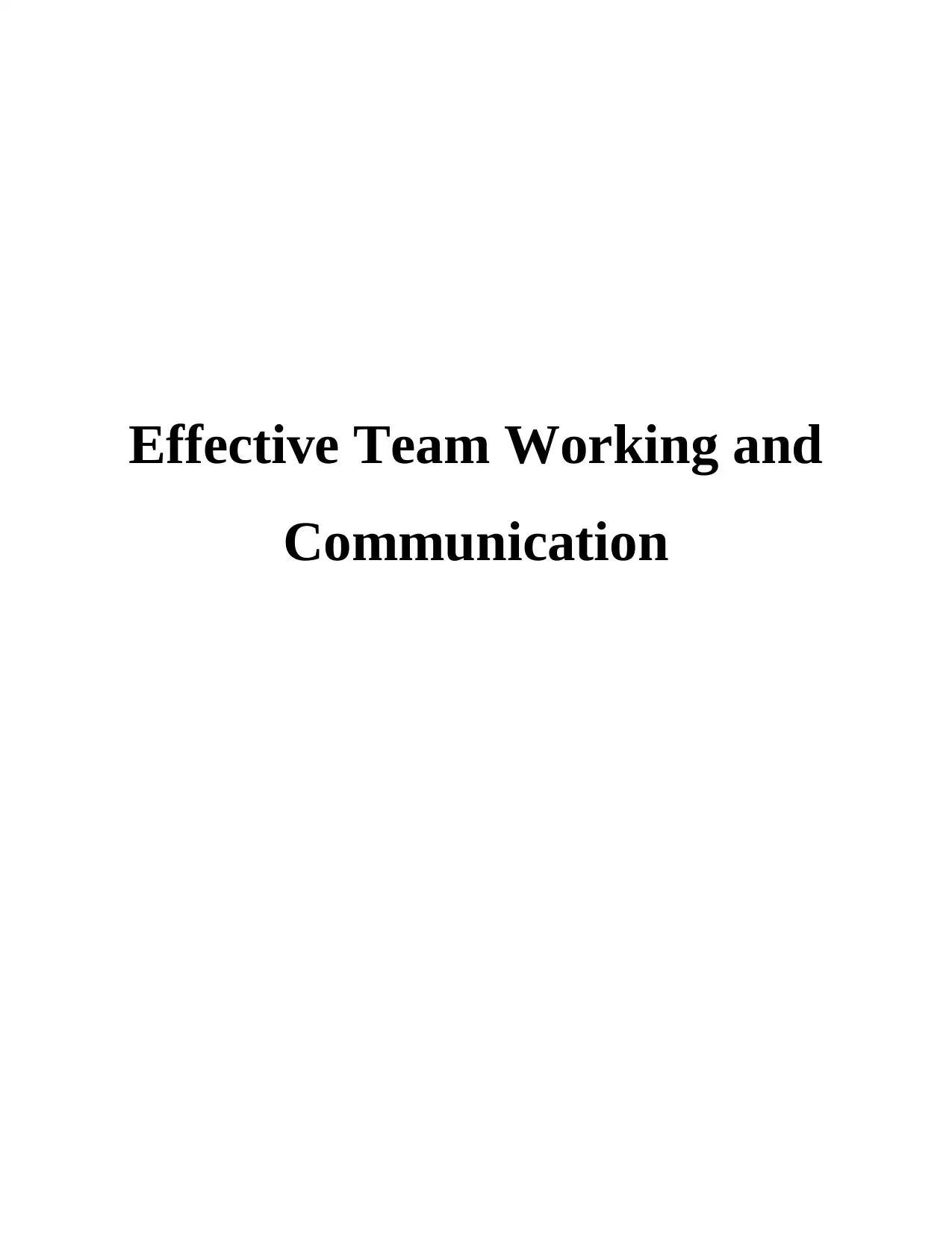
Effective Team Working and
Communication
Communication
Secure Best Marks with AI Grader
Need help grading? Try our AI Grader for instant feedback on your assignments.
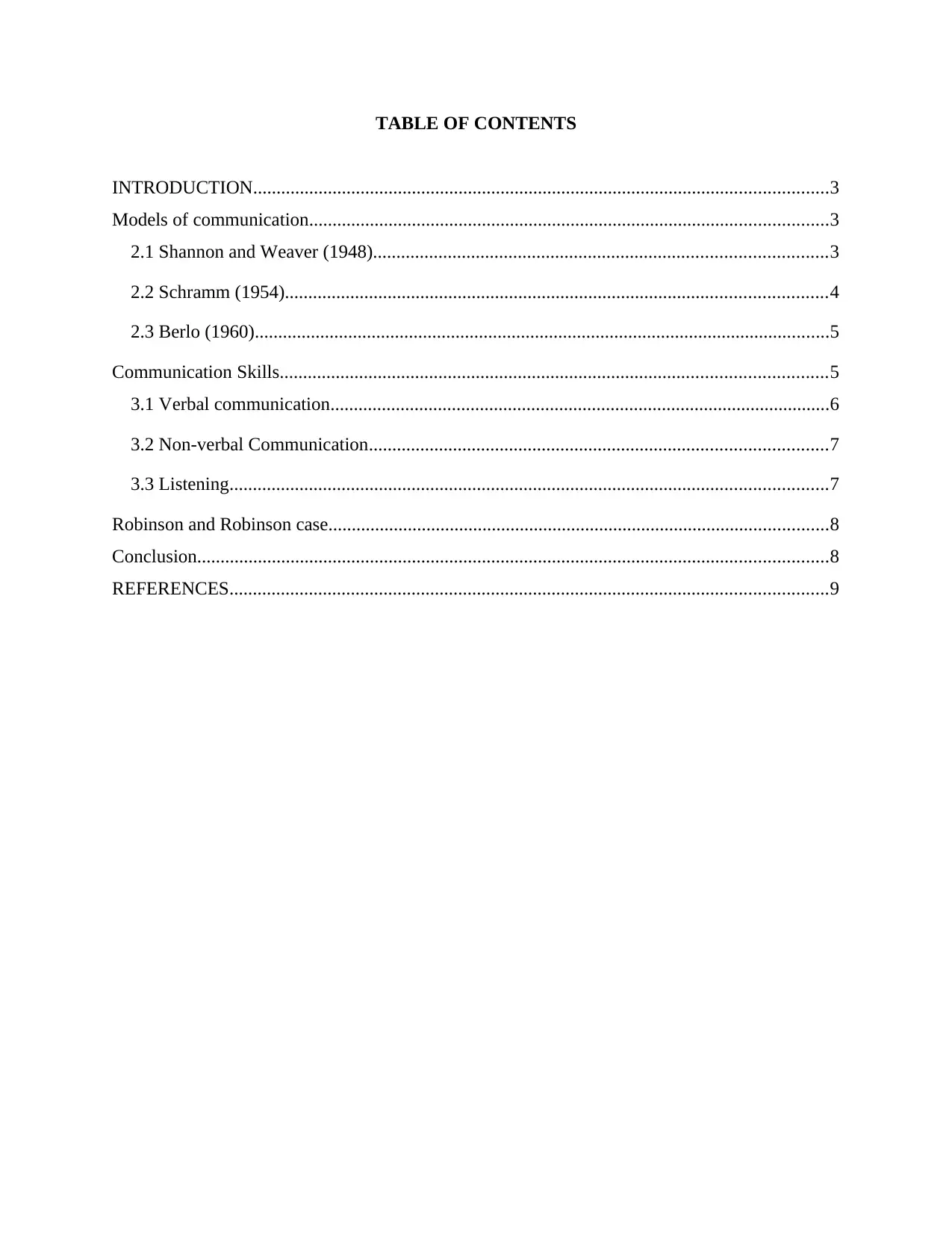
TABLE OF CONTENTS
INTRODUCTION...........................................................................................................................3
Models of communication...............................................................................................................3
2.1 Shannon and Weaver (1948).................................................................................................3
2.2 Schramm (1954)....................................................................................................................4
2.3 Berlo (1960)...........................................................................................................................5
Communication Skills.....................................................................................................................5
3.1 Verbal communication...........................................................................................................6
3.2 Non-verbal Communication..................................................................................................7
3.3 Listening................................................................................................................................7
Robinson and Robinson case...........................................................................................................8
Conclusion.......................................................................................................................................8
REFERENCES................................................................................................................................9
INTRODUCTION...........................................................................................................................3
Models of communication...............................................................................................................3
2.1 Shannon and Weaver (1948).................................................................................................3
2.2 Schramm (1954)....................................................................................................................4
2.3 Berlo (1960)...........................................................................................................................5
Communication Skills.....................................................................................................................5
3.1 Verbal communication...........................................................................................................6
3.2 Non-verbal Communication..................................................................................................7
3.3 Listening................................................................................................................................7
Robinson and Robinson case...........................................................................................................8
Conclusion.......................................................................................................................................8
REFERENCES................................................................................................................................9
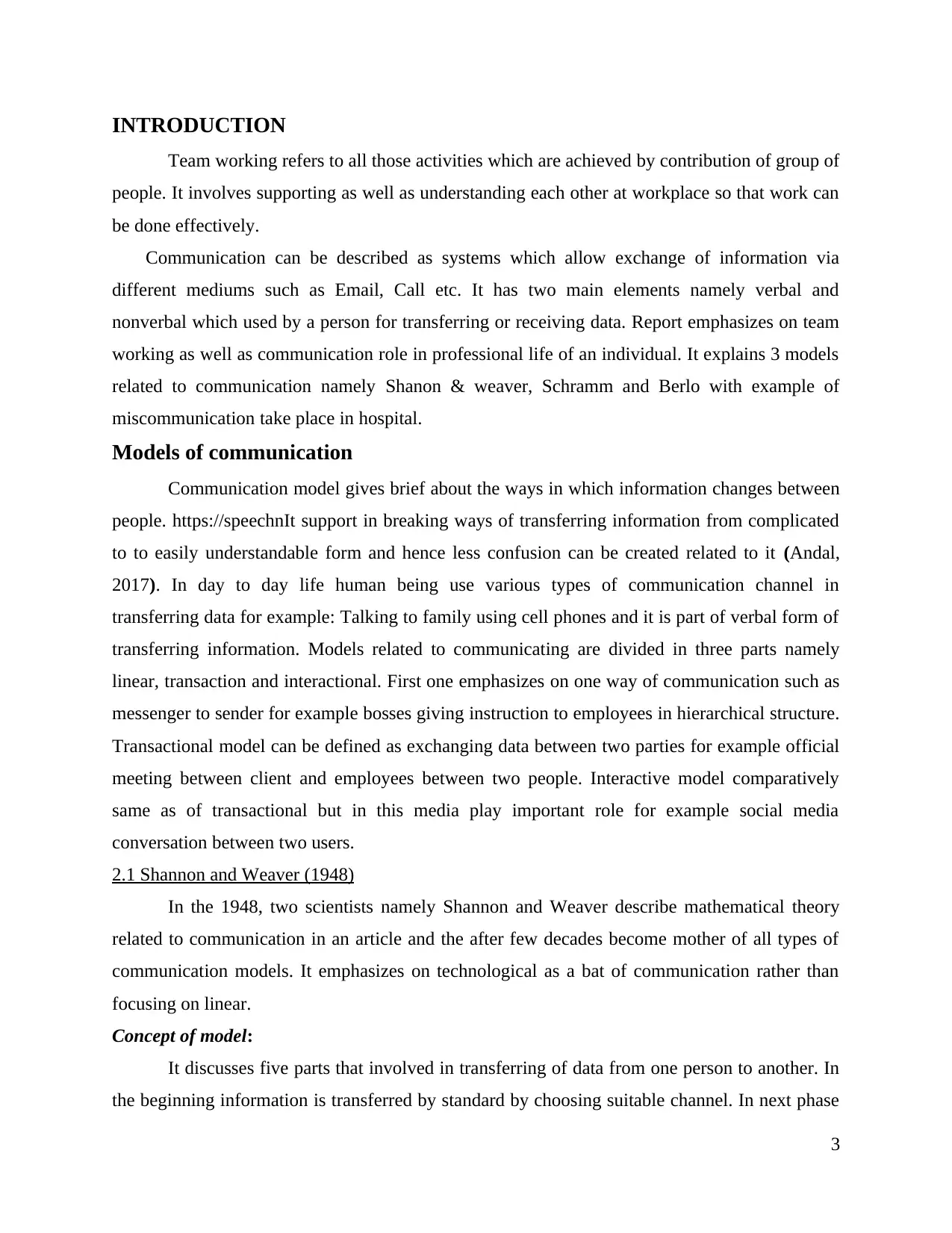
INTRODUCTION
Team working refers to all those activities which are achieved by contribution of group of
people. It involves supporting as well as understanding each other at workplace so that work can
be done effectively.
Communication can be described as systems which allow exchange of information via
different mediums such as Email, Call etc. It has two main elements namely verbal and
nonverbal which used by a person for transferring or receiving data. Report emphasizes on team
working as well as communication role in professional life of an individual. It explains 3 models
related to communication namely Shanon & weaver, Schramm and Berlo with example of
miscommunication take place in hospital.
Models of communication
Communication model gives brief about the ways in which information changes between
people. https://speechnIt support in breaking ways of transferring information from complicated
to to easily understandable form and hence less confusion can be created related to it (Andal,
2017). In day to day life human being use various types of communication channel in
transferring data for example: Talking to family using cell phones and it is part of verbal form of
transferring information. Models related to communicating are divided in three parts namely
linear, transaction and interactional. First one emphasizes on one way of communication such as
messenger to sender for example bosses giving instruction to employees in hierarchical structure.
Transactional model can be defined as exchanging data between two parties for example official
meeting between client and employees between two people. Interactive model comparatively
same as of transactional but in this media play important role for example social media
conversation between two users.
2.1 Shannon and Weaver (1948)
In the 1948, two scientists namely Shannon and Weaver describe mathematical theory
related to communication in an article and the after few decades become mother of all types of
communication models. It emphasizes on technological as a bat of communication rather than
focusing on linear.
Concept of model:
It discusses five parts that involved in transferring of data from one person to another. In
the beginning information is transferred by standard by choosing suitable channel. In next phase
3
Team working refers to all those activities which are achieved by contribution of group of
people. It involves supporting as well as understanding each other at workplace so that work can
be done effectively.
Communication can be described as systems which allow exchange of information via
different mediums such as Email, Call etc. It has two main elements namely verbal and
nonverbal which used by a person for transferring or receiving data. Report emphasizes on team
working as well as communication role in professional life of an individual. It explains 3 models
related to communication namely Shanon & weaver, Schramm and Berlo with example of
miscommunication take place in hospital.
Models of communication
Communication model gives brief about the ways in which information changes between
people. https://speechnIt support in breaking ways of transferring information from complicated
to to easily understandable form and hence less confusion can be created related to it (Andal,
2017). In day to day life human being use various types of communication channel in
transferring data for example: Talking to family using cell phones and it is part of verbal form of
transferring information. Models related to communicating are divided in three parts namely
linear, transaction and interactional. First one emphasizes on one way of communication such as
messenger to sender for example bosses giving instruction to employees in hierarchical structure.
Transactional model can be defined as exchanging data between two parties for example official
meeting between client and employees between two people. Interactive model comparatively
same as of transactional but in this media play important role for example social media
conversation between two users.
2.1 Shannon and Weaver (1948)
In the 1948, two scientists namely Shannon and Weaver describe mathematical theory
related to communication in an article and the after few decades become mother of all types of
communication models. It emphasizes on technological as a bat of communication rather than
focusing on linear.
Concept of model:
It discusses five parts that involved in transferring of data from one person to another. In
the beginning information is transferred by standard by choosing suitable channel. In next phase
3
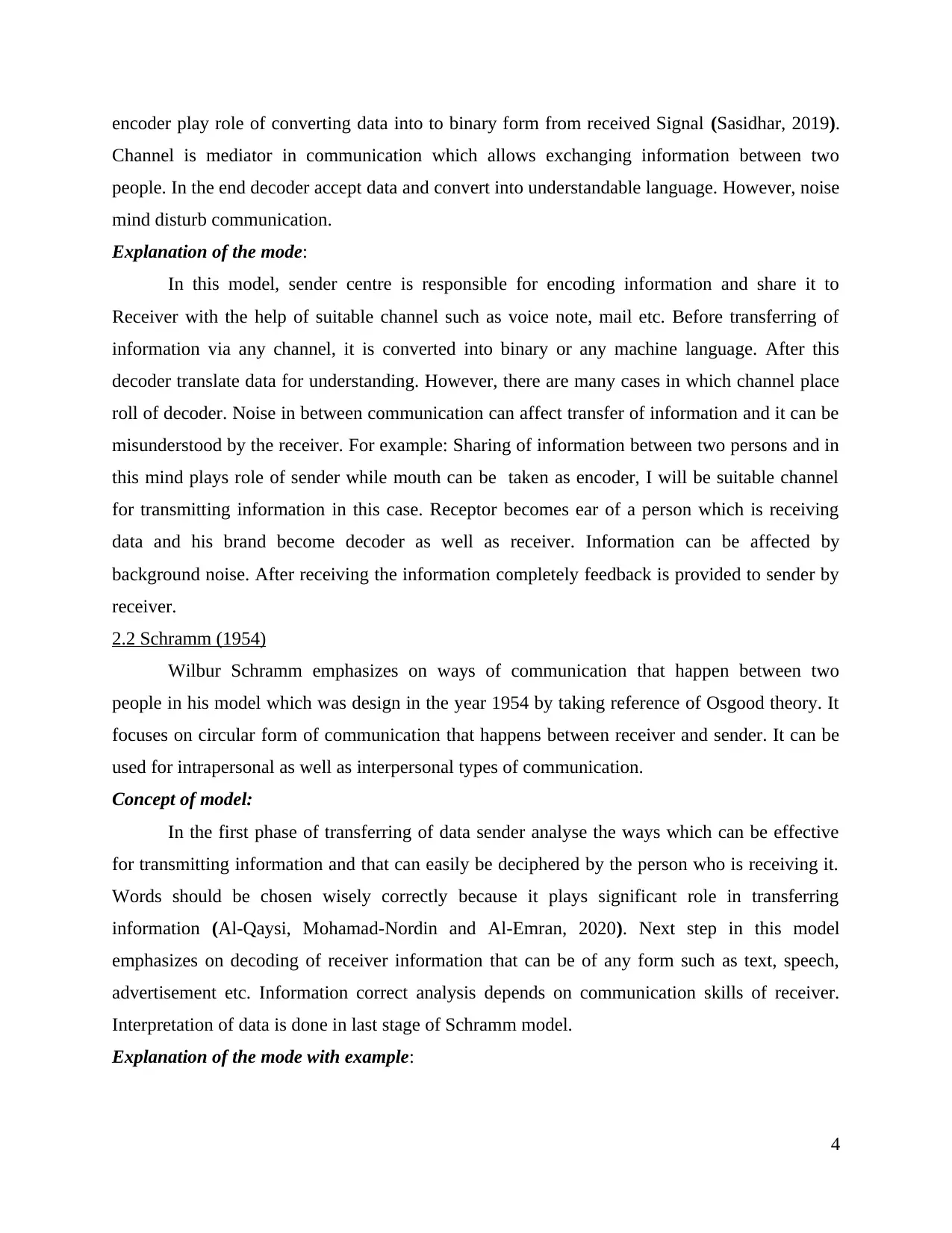
encoder play role of converting data into to binary form from received Signal (Sasidhar, 2019).
Channel is mediator in communication which allows exchanging information between two
people. In the end decoder accept data and convert into understandable language. However, noise
mind disturb communication.
Explanation of the mode:
In this model, sender centre is responsible for encoding information and share it to
Receiver with the help of suitable channel such as voice note, mail etc. Before transferring of
information via any channel, it is converted into binary or any machine language. After this
decoder translate data for understanding. However, there are many cases in which channel place
roll of decoder. Noise in between communication can affect transfer of information and it can be
misunderstood by the receiver. For example: Sharing of information between two persons and in
this mind plays role of sender while mouth can be taken as encoder, I will be suitable channel
for transmitting information in this case. Receptor becomes ear of a person which is receiving
data and his brand become decoder as well as receiver. Information can be affected by
background noise. After receiving the information completely feedback is provided to sender by
receiver.
2.2 Schramm (1954)
Wilbur Schramm emphasizes on ways of communication that happen between two
people in his model which was design in the year 1954 by taking reference of Osgood theory. It
focuses on circular form of communication that happens between receiver and sender. It can be
used for intrapersonal as well as interpersonal types of communication.
Concept of model:
In the first phase of transferring of data sender analyse the ways which can be effective
for transmitting information and that can easily be deciphered by the person who is receiving it.
Words should be chosen wisely correctly because it plays significant role in transferring
information (Al-Qaysi, Mohamad-Nordin and Al-Emran, 2020). Next step in this model
emphasizes on decoding of receiver information that can be of any form such as text, speech,
advertisement etc. Information correct analysis depends on communication skills of receiver.
Interpretation of data is done in last stage of Schramm model.
Explanation of the mode with example:
4
Channel is mediator in communication which allows exchanging information between two
people. In the end decoder accept data and convert into understandable language. However, noise
mind disturb communication.
Explanation of the mode:
In this model, sender centre is responsible for encoding information and share it to
Receiver with the help of suitable channel such as voice note, mail etc. Before transferring of
information via any channel, it is converted into binary or any machine language. After this
decoder translate data for understanding. However, there are many cases in which channel place
roll of decoder. Noise in between communication can affect transfer of information and it can be
misunderstood by the receiver. For example: Sharing of information between two persons and in
this mind plays role of sender while mouth can be taken as encoder, I will be suitable channel
for transmitting information in this case. Receptor becomes ear of a person which is receiving
data and his brand become decoder as well as receiver. Information can be affected by
background noise. After receiving the information completely feedback is provided to sender by
receiver.
2.2 Schramm (1954)
Wilbur Schramm emphasizes on ways of communication that happen between two
people in his model which was design in the year 1954 by taking reference of Osgood theory. It
focuses on circular form of communication that happens between receiver and sender. It can be
used for intrapersonal as well as interpersonal types of communication.
Concept of model:
In the first phase of transferring of data sender analyse the ways which can be effective
for transmitting information and that can easily be deciphered by the person who is receiving it.
Words should be chosen wisely correctly because it plays significant role in transferring
information (Al-Qaysi, Mohamad-Nordin and Al-Emran, 2020). Next step in this model
emphasizes on decoding of receiver information that can be of any form such as text, speech,
advertisement etc. Information correct analysis depends on communication skills of receiver.
Interpretation of data is done in last stage of Schramm model.
Explanation of the mode with example:
4
Secure Best Marks with AI Grader
Need help grading? Try our AI Grader for instant feedback on your assignments.
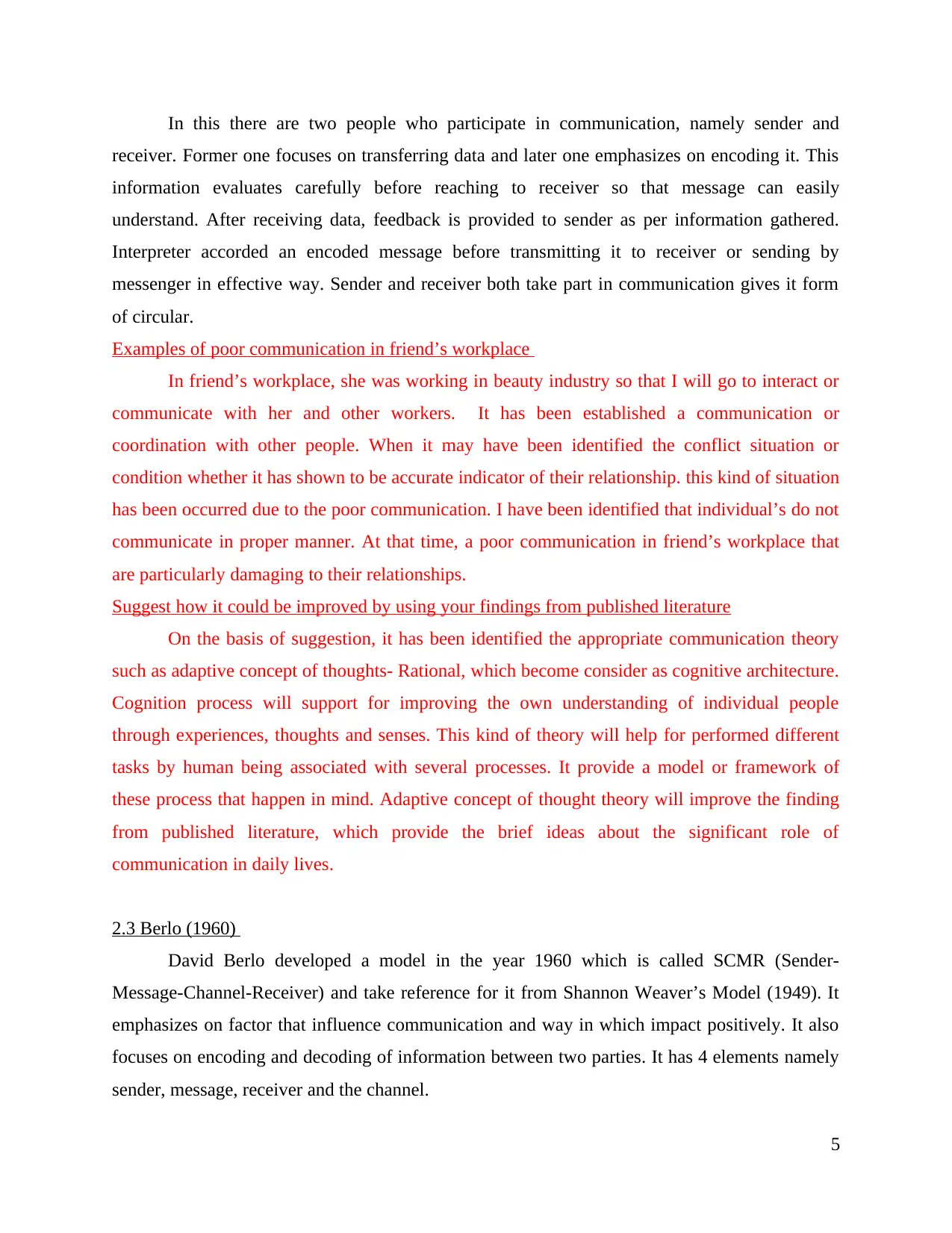
In this there are two people who participate in communication, namely sender and
receiver. Former one focuses on transferring data and later one emphasizes on encoding it. This
information evaluates carefully before reaching to receiver so that message can easily
understand. After receiving data, feedback is provided to sender as per information gathered.
Interpreter accorded an encoded message before transmitting it to receiver or sending by
messenger in effective way. Sender and receiver both take part in communication gives it form
of circular.
Examples of poor communication in friend’s workplace
In friend’s workplace, she was working in beauty industry so that I will go to interact or
communicate with her and other workers. It has been established a communication or
coordination with other people. When it may have been identified the conflict situation or
condition whether it has shown to be accurate indicator of their relationship. this kind of situation
has been occurred due to the poor communication. I have been identified that individual’s do not
communicate in proper manner. At that time, a poor communication in friend’s workplace that
are particularly damaging to their relationships.
Suggest how it could be improved by using your findings from published literature
On the basis of suggestion, it has been identified the appropriate communication theory
such as adaptive concept of thoughts- Rational, which become consider as cognitive architecture.
Cognition process will support for improving the own understanding of individual people
through experiences, thoughts and senses. This kind of theory will help for performed different
tasks by human being associated with several processes. It provide a model or framework of
these process that happen in mind. Adaptive concept of thought theory will improve the finding
from published literature, which provide the brief ideas about the significant role of
communication in daily lives.
2.3 Berlo (1960)
David Berlo developed a model in the year 1960 which is called SCMR (Sender-
Message-Channel-Receiver) and take reference for it from Shannon Weaver’s Model (1949). It
emphasizes on factor that influence communication and way in which impact positively. It also
focuses on encoding and decoding of information between two parties. It has 4 elements namely
sender, message, receiver and the channel.
5
receiver. Former one focuses on transferring data and later one emphasizes on encoding it. This
information evaluates carefully before reaching to receiver so that message can easily
understand. After receiving data, feedback is provided to sender as per information gathered.
Interpreter accorded an encoded message before transmitting it to receiver or sending by
messenger in effective way. Sender and receiver both take part in communication gives it form
of circular.
Examples of poor communication in friend’s workplace
In friend’s workplace, she was working in beauty industry so that I will go to interact or
communicate with her and other workers. It has been established a communication or
coordination with other people. When it may have been identified the conflict situation or
condition whether it has shown to be accurate indicator of their relationship. this kind of situation
has been occurred due to the poor communication. I have been identified that individual’s do not
communicate in proper manner. At that time, a poor communication in friend’s workplace that
are particularly damaging to their relationships.
Suggest how it could be improved by using your findings from published literature
On the basis of suggestion, it has been identified the appropriate communication theory
such as adaptive concept of thoughts- Rational, which become consider as cognitive architecture.
Cognition process will support for improving the own understanding of individual people
through experiences, thoughts and senses. This kind of theory will help for performed different
tasks by human being associated with several processes. It provide a model or framework of
these process that happen in mind. Adaptive concept of thought theory will improve the finding
from published literature, which provide the brief ideas about the significant role of
communication in daily lives.
2.3 Berlo (1960)
David Berlo developed a model in the year 1960 which is called SCMR (Sender-
Message-Channel-Receiver) and take reference for it from Shannon Weaver’s Model (1949). It
emphasizes on factor that influence communication and way in which impact positively. It also
focuses on encoding and decoding of information between two parties. It has 4 elements namely
sender, message, receiver and the channel.
5
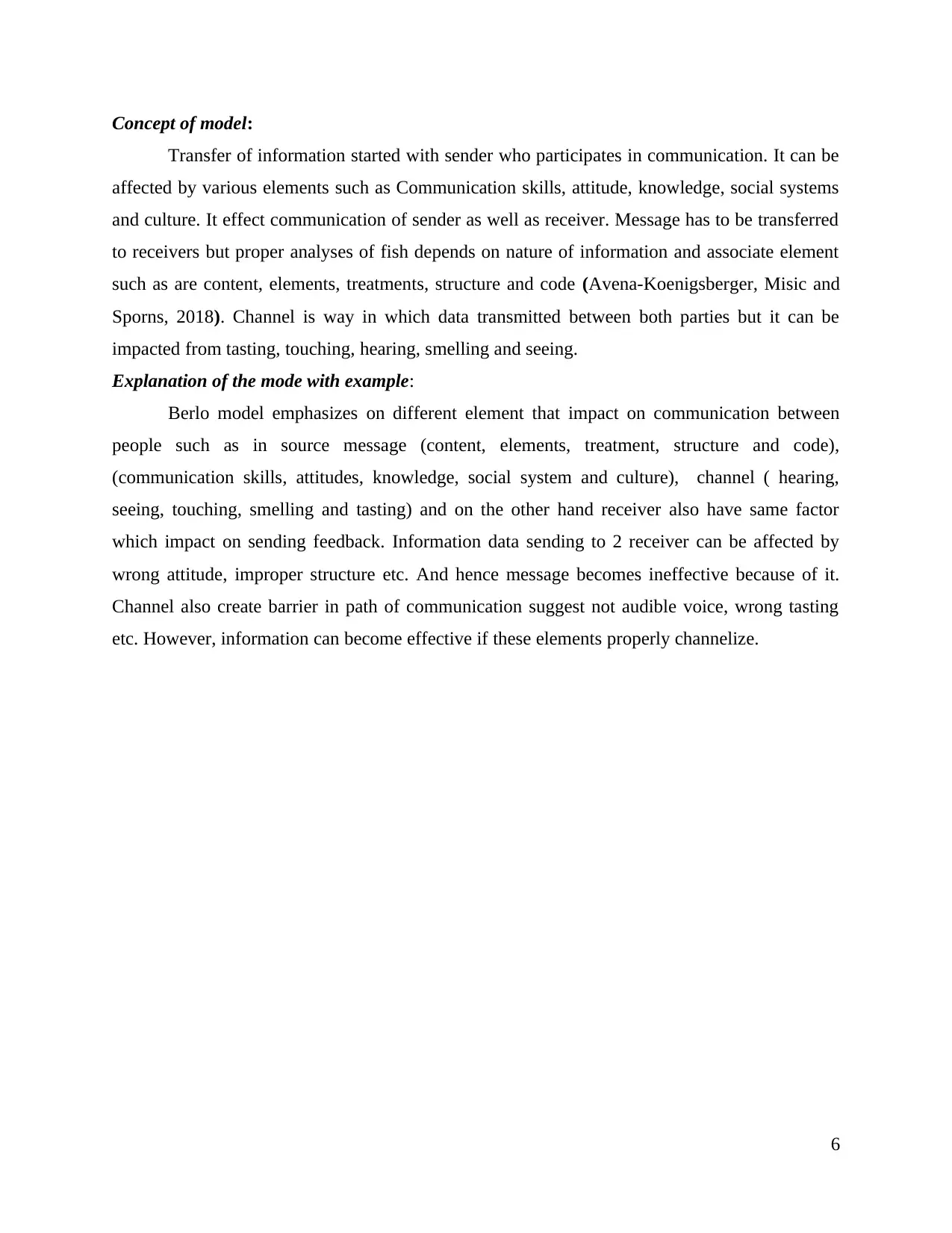
Concept of model:
Transfer of information started with sender who participates in communication. It can be
affected by various elements such as Communication skills, attitude, knowledge, social systems
and culture. It effect communication of sender as well as receiver. Message has to be transferred
to receivers but proper analyses of fish depends on nature of information and associate element
such as are content, elements, treatments, structure and code (Avena-Koenigsberger, Misic and
Sporns, 2018). Channel is way in which data transmitted between both parties but it can be
impacted from tasting, touching, hearing, smelling and seeing.
Explanation of the mode with example:
Berlo model emphasizes on different element that impact on communication between
people such as in source message (content, elements, treatment, structure and code),
(communication skills, attitudes, knowledge, social system and culture), channel ( hearing,
seeing, touching, smelling and tasting) and on the other hand receiver also have same factor
which impact on sending feedback. Information data sending to 2 receiver can be affected by
wrong attitude, improper structure etc. And hence message becomes ineffective because of it.
Channel also create barrier in path of communication suggest not audible voice, wrong tasting
etc. However, information can become effective if these elements properly channelize.
6
Transfer of information started with sender who participates in communication. It can be
affected by various elements such as Communication skills, attitude, knowledge, social systems
and culture. It effect communication of sender as well as receiver. Message has to be transferred
to receivers but proper analyses of fish depends on nature of information and associate element
such as are content, elements, treatments, structure and code (Avena-Koenigsberger, Misic and
Sporns, 2018). Channel is way in which data transmitted between both parties but it can be
impacted from tasting, touching, hearing, smelling and seeing.
Explanation of the mode with example:
Berlo model emphasizes on different element that impact on communication between
people such as in source message (content, elements, treatment, structure and code),
(communication skills, attitudes, knowledge, social system and culture), channel ( hearing,
seeing, touching, smelling and tasting) and on the other hand receiver also have same factor
which impact on sending feedback. Information data sending to 2 receiver can be affected by
wrong attitude, improper structure etc. And hence message becomes ineffective because of it.
Channel also create barrier in path of communication suggest not audible voice, wrong tasting
etc. However, information can become effective if these elements properly channelize.
6
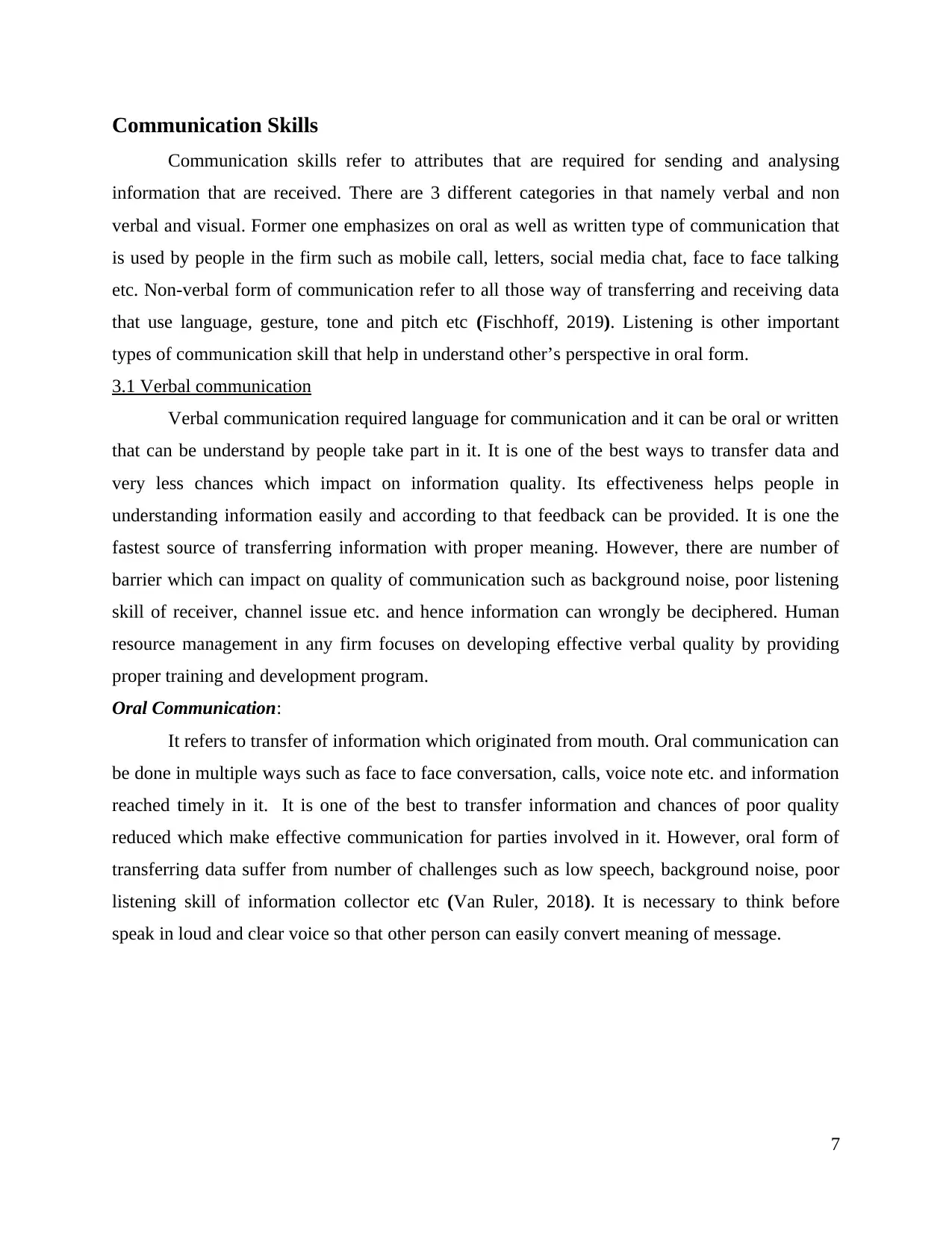
Communication Skills
Communication skills refer to attributes that are required for sending and analysing
information that are received. There are 3 different categories in that namely verbal and non
verbal and visual. Former one emphasizes on oral as well as written type of communication that
is used by people in the firm such as mobile call, letters, social media chat, face to face talking
etc. Non-verbal form of communication refer to all those way of transferring and receiving data
that use language, gesture, tone and pitch etc (Fischhoff, 2019). Listening is other important
types of communication skill that help in understand other’s perspective in oral form.
3.1 Verbal communication
Verbal communication required language for communication and it can be oral or written
that can be understand by people take part in it. It is one of the best ways to transfer data and
very less chances which impact on information quality. Its effectiveness helps people in
understanding information easily and according to that feedback can be provided. It is one the
fastest source of transferring information with proper meaning. However, there are number of
barrier which can impact on quality of communication such as background noise, poor listening
skill of receiver, channel issue etc. and hence information can wrongly be deciphered. Human
resource management in any firm focuses on developing effective verbal quality by providing
proper training and development program.
Oral Communication:
It refers to transfer of information which originated from mouth. Oral communication can
be done in multiple ways such as face to face conversation, calls, voice note etc. and information
reached timely in it. It is one of the best to transfer information and chances of poor quality
reduced which make effective communication for parties involved in it. However, oral form of
transferring data suffer from number of challenges such as low speech, background noise, poor
listening skill of information collector etc (Van Ruler, 2018). It is necessary to think before
speak in loud and clear voice so that other person can easily convert meaning of message.
7
Communication skills refer to attributes that are required for sending and analysing
information that are received. There are 3 different categories in that namely verbal and non
verbal and visual. Former one emphasizes on oral as well as written type of communication that
is used by people in the firm such as mobile call, letters, social media chat, face to face talking
etc. Non-verbal form of communication refer to all those way of transferring and receiving data
that use language, gesture, tone and pitch etc (Fischhoff, 2019). Listening is other important
types of communication skill that help in understand other’s perspective in oral form.
3.1 Verbal communication
Verbal communication required language for communication and it can be oral or written
that can be understand by people take part in it. It is one of the best ways to transfer data and
very less chances which impact on information quality. Its effectiveness helps people in
understanding information easily and according to that feedback can be provided. It is one the
fastest source of transferring information with proper meaning. However, there are number of
barrier which can impact on quality of communication such as background noise, poor listening
skill of receiver, channel issue etc. and hence information can wrongly be deciphered. Human
resource management in any firm focuses on developing effective verbal quality by providing
proper training and development program.
Oral Communication:
It refers to transfer of information which originated from mouth. Oral communication can
be done in multiple ways such as face to face conversation, calls, voice note etc. and information
reached timely in it. It is one of the best to transfer information and chances of poor quality
reduced which make effective communication for parties involved in it. However, oral form of
transferring data suffer from number of challenges such as low speech, background noise, poor
listening skill of information collector etc (Van Ruler, 2018). It is necessary to think before
speak in loud and clear voice so that other person can easily convert meaning of message.
7
Paraphrase This Document
Need a fresh take? Get an instant paraphrase of this document with our AI Paraphraser
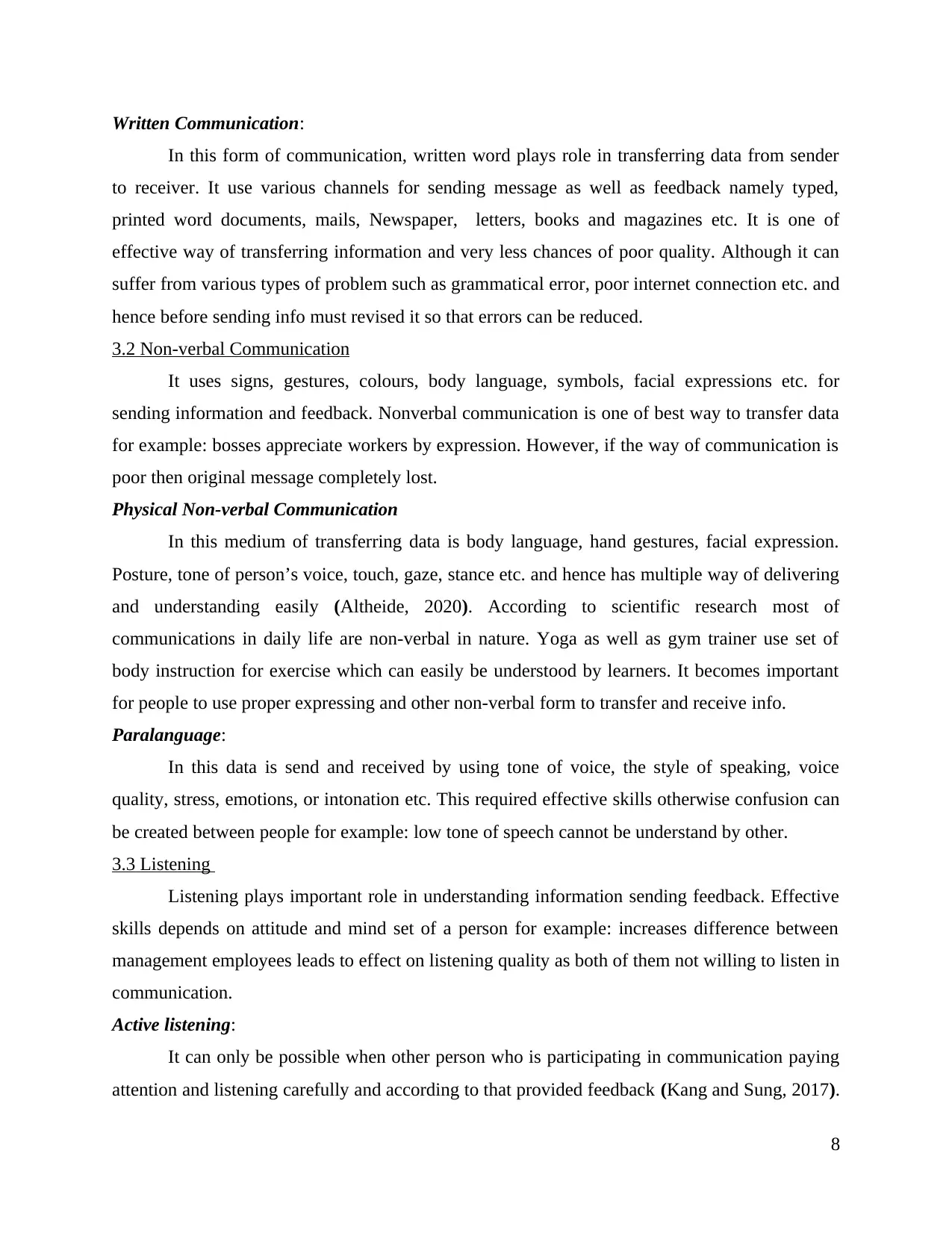
Written Communication:
In this form of communication, written word plays role in transferring data from sender
to receiver. It use various channels for sending message as well as feedback namely typed,
printed word documents, mails, Newspaper, letters, books and magazines etc. It is one of
effective way of transferring information and very less chances of poor quality. Although it can
suffer from various types of problem such as grammatical error, poor internet connection etc. and
hence before sending info must revised it so that errors can be reduced.
3.2 Non-verbal Communication
It uses signs, gestures, colours, body language, symbols, facial expressions etc. for
sending information and feedback. Nonverbal communication is one of best way to transfer data
for example: bosses appreciate workers by expression. However, if the way of communication is
poor then original message completely lost.
Physical Non-verbal Communication
In this medium of transferring data is body language, hand gestures, facial expression.
Posture, tone of person’s voice, touch, gaze, stance etc. and hence has multiple way of delivering
and understanding easily (Altheide, 2020). According to scientific research most of
communications in daily life are non-verbal in nature. Yoga as well as gym trainer use set of
body instruction for exercise which can easily be understood by learners. It becomes important
for people to use proper expressing and other non-verbal form to transfer and receive info.
Paralanguage:
In this data is send and received by using tone of voice, the style of speaking, voice
quality, stress, emotions, or intonation etc. This required effective skills otherwise confusion can
be created between people for example: low tone of speech cannot be understand by other.
3.3 Listening
Listening plays important role in understanding information sending feedback. Effective
skills depends on attitude and mind set of a person for example: increases difference between
management employees leads to effect on listening quality as both of them not willing to listen in
communication.
Active listening:
It can only be possible when other person who is participating in communication paying
attention and listening carefully and according to that provided feedback (Kang and Sung, 2017).
8
In this form of communication, written word plays role in transferring data from sender
to receiver. It use various channels for sending message as well as feedback namely typed,
printed word documents, mails, Newspaper, letters, books and magazines etc. It is one of
effective way of transferring information and very less chances of poor quality. Although it can
suffer from various types of problem such as grammatical error, poor internet connection etc. and
hence before sending info must revised it so that errors can be reduced.
3.2 Non-verbal Communication
It uses signs, gestures, colours, body language, symbols, facial expressions etc. for
sending information and feedback. Nonverbal communication is one of best way to transfer data
for example: bosses appreciate workers by expression. However, if the way of communication is
poor then original message completely lost.
Physical Non-verbal Communication
In this medium of transferring data is body language, hand gestures, facial expression.
Posture, tone of person’s voice, touch, gaze, stance etc. and hence has multiple way of delivering
and understanding easily (Altheide, 2020). According to scientific research most of
communications in daily life are non-verbal in nature. Yoga as well as gym trainer use set of
body instruction for exercise which can easily be understood by learners. It becomes important
for people to use proper expressing and other non-verbal form to transfer and receive info.
Paralanguage:
In this data is send and received by using tone of voice, the style of speaking, voice
quality, stress, emotions, or intonation etc. This required effective skills otherwise confusion can
be created between people for example: low tone of speech cannot be understand by other.
3.3 Listening
Listening plays important role in understanding information sending feedback. Effective
skills depends on attitude and mind set of a person for example: increases difference between
management employees leads to effect on listening quality as both of them not willing to listen in
communication.
Active listening:
It can only be possible when other person who is participating in communication paying
attention and listening carefully and according to that provided feedback (Kang and Sung, 2017).
8
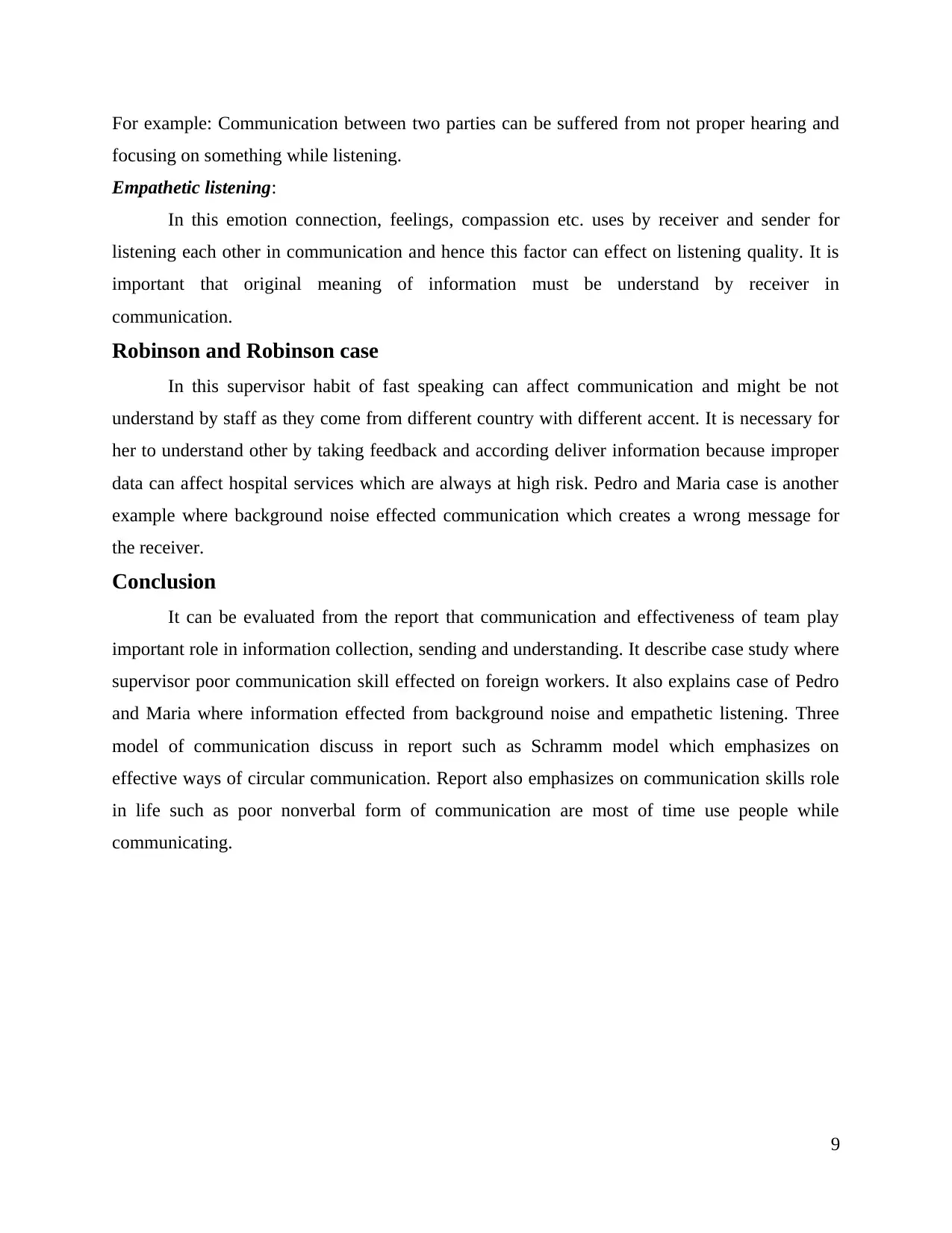
For example: Communication between two parties can be suffered from not proper hearing and
focusing on something while listening.
Empathetic listening:
In this emotion connection, feelings, compassion etc. uses by receiver and sender for
listening each other in communication and hence this factor can effect on listening quality. It is
important that original meaning of information must be understand by receiver in
communication.
Robinson and Robinson case
In this supervisor habit of fast speaking can affect communication and might be not
understand by staff as they come from different country with different accent. It is necessary for
her to understand other by taking feedback and according deliver information because improper
data can affect hospital services which are always at high risk. Pedro and Maria case is another
example where background noise effected communication which creates a wrong message for
the receiver.
Conclusion
It can be evaluated from the report that communication and effectiveness of team play
important role in information collection, sending and understanding. It describe case study where
supervisor poor communication skill effected on foreign workers. It also explains case of Pedro
and Maria where information effected from background noise and empathetic listening. Three
model of communication discuss in report such as Schramm model which emphasizes on
effective ways of circular communication. Report also emphasizes on communication skills role
in life such as poor nonverbal form of communication are most of time use people while
communicating.
9
focusing on something while listening.
Empathetic listening:
In this emotion connection, feelings, compassion etc. uses by receiver and sender for
listening each other in communication and hence this factor can effect on listening quality. It is
important that original meaning of information must be understand by receiver in
communication.
Robinson and Robinson case
In this supervisor habit of fast speaking can affect communication and might be not
understand by staff as they come from different country with different accent. It is necessary for
her to understand other by taking feedback and according deliver information because improper
data can affect hospital services which are always at high risk. Pedro and Maria case is another
example where background noise effected communication which creates a wrong message for
the receiver.
Conclusion
It can be evaluated from the report that communication and effectiveness of team play
important role in information collection, sending and understanding. It describe case study where
supervisor poor communication skill effected on foreign workers. It also explains case of Pedro
and Maria where information effected from background noise and empathetic listening. Three
model of communication discuss in report such as Schramm model which emphasizes on
effective ways of circular communication. Report also emphasizes on communication skills role
in life such as poor nonverbal form of communication are most of time use people while
communicating.
9
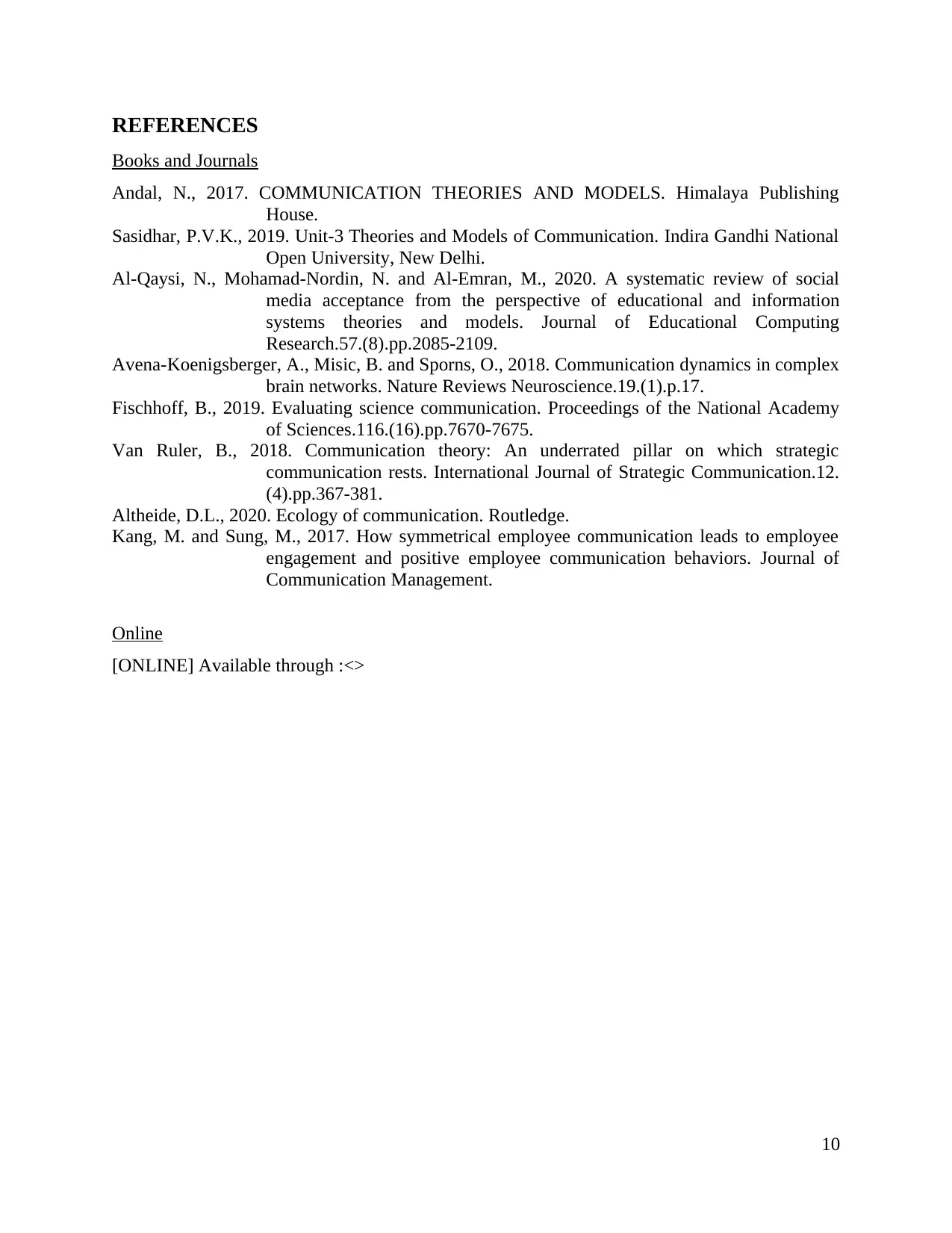
REFERENCES
Books and Journals
Andal, N., 2017. COMMUNICATION THEORIES AND MODELS. Himalaya Publishing
House.
Sasidhar, P.V.K., 2019. Unit-3 Theories and Models of Communication. Indira Gandhi National
Open University, New Delhi.
Al-Qaysi, N., Mohamad-Nordin, N. and Al-Emran, M., 2020. A systematic review of social
media acceptance from the perspective of educational and information
systems theories and models. Journal of Educational Computing
Research.57.(8).pp.2085-2109.
Avena-Koenigsberger, A., Misic, B. and Sporns, O., 2018. Communication dynamics in complex
brain networks. Nature Reviews Neuroscience.19.(1).p.17.
Fischhoff, B., 2019. Evaluating science communication. Proceedings of the National Academy
of Sciences.116.(16).pp.7670-7675.
Van Ruler, B., 2018. Communication theory: An underrated pillar on which strategic
communication rests. International Journal of Strategic Communication.12.
(4).pp.367-381.
Altheide, D.L., 2020. Ecology of communication. Routledge.
Kang, M. and Sung, M., 2017. How symmetrical employee communication leads to employee
engagement and positive employee communication behaviors. Journal of
Communication Management.
Online
[ONLINE] Available through :<>
10
Books and Journals
Andal, N., 2017. COMMUNICATION THEORIES AND MODELS. Himalaya Publishing
House.
Sasidhar, P.V.K., 2019. Unit-3 Theories and Models of Communication. Indira Gandhi National
Open University, New Delhi.
Al-Qaysi, N., Mohamad-Nordin, N. and Al-Emran, M., 2020. A systematic review of social
media acceptance from the perspective of educational and information
systems theories and models. Journal of Educational Computing
Research.57.(8).pp.2085-2109.
Avena-Koenigsberger, A., Misic, B. and Sporns, O., 2018. Communication dynamics in complex
brain networks. Nature Reviews Neuroscience.19.(1).p.17.
Fischhoff, B., 2019. Evaluating science communication. Proceedings of the National Academy
of Sciences.116.(16).pp.7670-7675.
Van Ruler, B., 2018. Communication theory: An underrated pillar on which strategic
communication rests. International Journal of Strategic Communication.12.
(4).pp.367-381.
Altheide, D.L., 2020. Ecology of communication. Routledge.
Kang, M. and Sung, M., 2017. How symmetrical employee communication leads to employee
engagement and positive employee communication behaviors. Journal of
Communication Management.
Online
[ONLINE] Available through :<>
10
Secure Best Marks with AI Grader
Need help grading? Try our AI Grader for instant feedback on your assignments.

11
1 out of 11
Related Documents
Your All-in-One AI-Powered Toolkit for Academic Success.
+13062052269
info@desklib.com
Available 24*7 on WhatsApp / Email
![[object Object]](/_next/static/media/star-bottom.7253800d.svg)
Unlock your academic potential
© 2024 | Zucol Services PVT LTD | All rights reserved.




